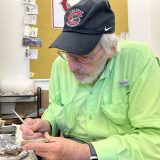Science Behind Nutrition: Careers in giving food more substance
June 26, 2014
This article, written by Joe Yogerst, originally appeared on the Los Angeles Times website.
With job prospects in food science expected to grow 10% over the next six years according to the U.S. Department of Labor, Chapman University is helping to meet this demand by offering a master of science in food science.
At Chapman’s Schmid College of Science and Technology, faculty and graduate students are confronting food and nutrition related issues head on. “Gaps — and their related opportunities — exist across the food industry for improving food safety, consumer health awareness and manufacturing efficiencies,” said Debra Topham, a food science instructor at Schmid.
Recent advances in the field for making food more nutritious include new versions of nutrient additives such as vitamin D and, in particular, one called Sunshine Vitamin that is water-soluble, rather than fat-soluble, and ideal for water-based foods like fruit juices and flavored beverages. It’s an innovative way to deliver a vitamin people used to get from the sun.
“This helps many age groups meet their nutritional needs,” Topham said, “as we spend more time indoors, away from natural sunlight during winter months … as well as in communities during high-smog alerts when sunlight does not penetrate this man-made barrier.”
Other advances include new formulations to make foods less allergenic: sunflower seed butter substituting for peanut butter, adapted rice proteins and vegetable-based ingredients replacing wheat gluten, as well as almond-based beverages to replace cow’s milk.
Cost-efficient tapioca-based ingredients are in development as a substitute for corn, which is increasingly diverted to ethanol (energy) production. Researchers are also exploring alternative gums and sweeteners such as stevia to produce flavorful no- and low-calorie foods with better stability and manufacturing capabilities. The food-processing industry is also creating better packaging and refrigeration-distribution methods for year-round access to fresh produce.
But Topham said there is much more to be done — not to mention a lot of business opportunities developing new ingredients, procedures and products. One of the needs that Topham foresees is the development of a kit for convenient detection of specific chemicals in order to prevent cross-contamination, adulteration and fraud in food. She said there is also a need for faster ways to check for microorganisms that cause food-borne illness.
At Chapman University, recent research and course content includes a study on bone health for Orange County residents, ways to extend the shelf life of food and in-depth evaluations of ingredients used by athletes to see if they have any impact on health and improving strength or endurance.
Chapman faculty and staff are also working with local food ingredient suppliers to develop new food products that meet consumers’ nutritional needs in appealing new ways. “Currently, the students are exploring gluten-free snack foods with hip flavors like curry and popped quinoa for a novel crunch,” Topham said.
California is the nation’s largest food exporter, and over 1,500 food-processing companies are located within a 90-minute drive of Orange County. Chapman, located in Orange, is ideal for students pursuing food science careers and internship opportunities, as well as researching and monitoring trends in the field.


